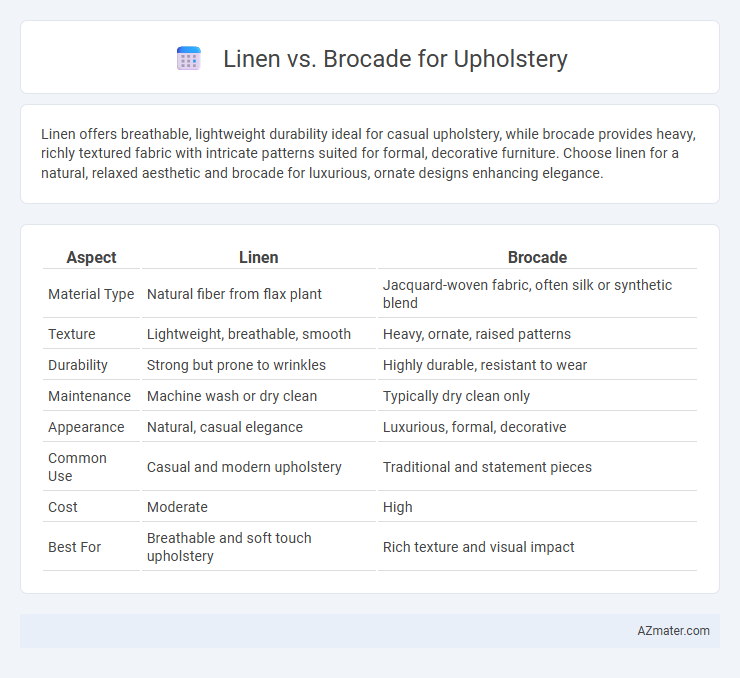Linen offers breathable, lightweight durability ideal for casual upholstery, while brocade provides heavy, richly textured fabric with intricate patterns suited for formal, decorative furniture. Choose linen for a natural, relaxed aesthetic and brocade for luxurious, ornate designs enhancing elegance.
Table of Comparison
| Aspect | Linen | Brocade |
|---|---|---|
| Material Type | Natural fiber from flax plant | Jacquard-woven fabric, often silk or synthetic blend |
| Texture | Lightweight, breathable, smooth | Heavy, ornate, raised patterns |
| Durability | Strong but prone to wrinkles | Highly durable, resistant to wear |
| Maintenance | Machine wash or dry clean | Typically dry clean only |
| Appearance | Natural, casual elegance | Luxurious, formal, decorative |
| Common Use | Casual and modern upholstery | Traditional and statement pieces |
| Cost | Moderate | High |
| Best For | Breathable and soft touch upholstery | Rich texture and visual impact |
Introduction to Upholstery Fabrics
Linen and brocade are two popular upholstery fabrics distinguished by their texture and durability. Linen, derived from flax fibers, offers a breathable, natural feel with a smooth matte finish, ideal for casual or contemporary interiors. Brocade, woven with elaborate patterns often using silk or synthetic threads, provides a luxurious, heavy texture suited for formal and traditional settings.
What is Linen?
Linen is a natural fiber derived from the flax plant, known for its durability, breathability, and moisture-wicking properties, making it ideal for upholstery in warm climates. Its textured weave and matte finish provide a casual, elegant look while resisting pilling and fading over time. Linen upholstery offers hypoallergenic benefits and is biodegradable, contributing to sustainable interior design choices.
What is Brocade?
Brocade is a richly decorative fabric characterized by intricate patterns woven with metallic or colored threads, often used in upholstery for a luxurious and textured finish. This fabric is typically heavier and more ornate compared to linen, making it ideal for formal settings or statement pieces in interior design. Brocade's durability and elaborate designs add elegance and depth to furniture, contrasting linen's natural, breathable, and minimalist qualities.
Appearance and Texture Comparison
Linen upholstery offers a natural, matte finish with a soft, breathable texture that enhances comfort and showcases subtle wrinkles for a relaxed, organic appearance. In contrast, brocade fabric displays a richly textured, glossy surface with intricate, raised patterns woven from silk or synthetic fibers, delivering a luxurious, ornate look ideal for formal settings. While linen exudes simplicity and durability, brocade provides visual depth and opulence, making the choice dependent on desired aesthetic and tactile experience.
Durability and Longevity
Linen upholstery offers moderate durability with natural fibers that resist pilling and soften over time, making it ideal for light to medium use in living rooms or bedrooms. Brocade, woven with intricate patterns and often blended with synthetic fibers, provides superior durability and resistance to wear, suitable for high-traffic areas and formal settings. While both fabrics can last years with proper care, brocade's dense weave and strength typically ensure greater longevity in upholstery applications.
Comfort and Breathability
Linen upholstery offers superior comfort and breathability due to its natural fibers that allow excellent air circulation, keeping seating cool and fresh. Brocade, woven with heavier, often synthetic threads and intricate patterns, tends to be less breathable and can retain heat, making it less comfortable in warm climates. Choosing linen ensures a soft, airy seating experience ideal for improving indoor air quality and comfort.
Maintenance and Cleaning
Linen upholstery requires gentle maintenance, needing regular vacuuming and prompt spot cleaning with mild detergents to prevent fabric damage and staining. Brocade, being a heavier, intricately woven fabric, demands professional cleaning to preserve its texture and elaborate patterns, as harsh treatments can cause fraying or color fading. Both fabrics benefit from immediate stain treatment, but brocade's durability is balanced by its higher cleaning complexity compared to the more breathable and easily refreshed linen.
Cost and Affordability
Linen upholstery is generally more affordable due to its natural fibers and widespread availability, making it a cost-effective choice for budget-conscious projects. Brocade fabric, characterized by intricate patterns and a heavier weight, tends to be more expensive due to its detailed weaving process and luxurious appeal. Choosing between linen and brocade depends largely on budget constraints and the desired aesthetic impact for the upholstered piece.
Best Uses: Linen vs Brocade
Linen offers a natural, breathable texture ideal for casual, everyday upholstery in living rooms and sunrooms due to its durability and comfort. Brocade, with its rich, intricate patterns and heavier fabric, suits formal settings such as dining rooms and traditional spaces where elegance and a luxurious appearance are prioritized. Choosing between linen and brocade depends on desired ambiance; linen fits relaxed, modern styles while brocade enhances opulent, classic interiors.
Which Upholstery Fabric Should You Choose?
Linen offers a natural, breathable texture ideal for casual, elegant upholstery, known for durability and ease of cleaning, while brocade provides opulent patterns and heavy weight, perfect for formal or statement pieces with rich texture and sheen. Choose linen for a light, versatile, and durable fabric that ages gracefully, making it suitable for high-traffic areas or relaxed interiors. Opt for brocade when seeking a luxurious, decorative fabric that enhances classic or traditional decor with intricate designs and a more delicate maintenance requirement.

Infographic: Linen vs Brocade for Upholstery
 azmater.com
azmater.com